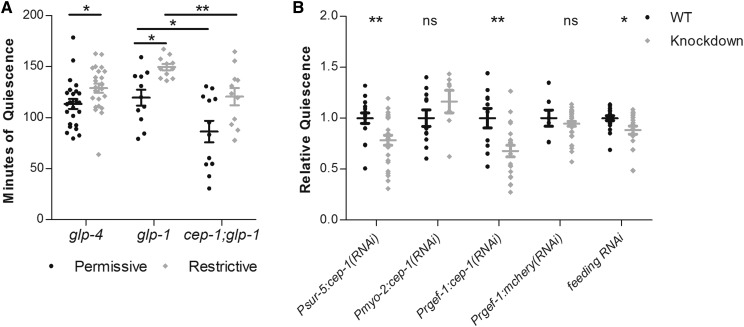Figure 4.
CEP-1 functions in neuronal cells to promote UVC-induced movement quiescence. (A) Total minutes of body-movement quiescence following UVC irradiation of glp-4(bn2) mutant animals, glp-1(e2141) mutant animals, and cep-1(gk138) I; glp-1(e2141) III double-mutant animals cultivated at the permissive (15°) or at the restrictive (25°) temperature. The N for each group: glp-4 N = 24 permissive and 24 restrictive, glp-1 N = 11 permissive and 11 restrictive, cep-1:glp-1 N = 11 permissive and 11 restrictive. (B) Body-movement quiescence, normalized to wild-type quiescence, of animals in which either cep-1 or mCherry was knocked down via transgenic expression of double-stranded RNA in specific cell types or was knocked down via the feeding RNAi method in a strain hypersensitive to RNAi in neurons (TU3401). Each point indicates an individual animal’s total quiescence divided by the mean quiescence of wild-type control animals imaged simultaneously. The N values and mean total minutes for each group are as follows. Psur-5:cep-1: wild type (WT), N = 16, mean = 118.7; knockdown, N = 35, mean = 92.98. Pmyo-2:cep-1: WT, N = 14, mean= 93; knockdown, N = 14, mean = 52.38. Pregef:cep-1: WT, N = 10, mean = 66.87; cep-1 knockdown, N = 21, mean = 45.29. Prgef-1:mcherry: WT, N = 7, mean = 133.5; knockdown, N = 35, mean = 126.2. * P < 0.05, ** P < 0.01, Student’s t-test comparing total minutes of quiescence of each mutant group to its control. In both panels, the wide and short horizontal bars denote mean and SE, respectively. ns, not significant.

